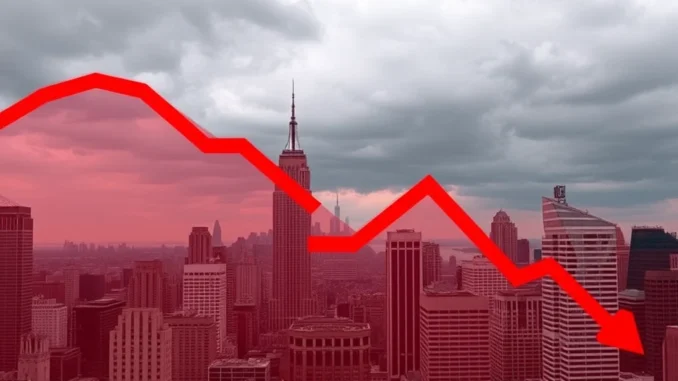
Buckle up, crypto enthusiasts! February witnessed a significant shift in the digital asset landscape as centralized exchange (CEX) trading volume experienced a dramatic downturn. A whopping 21% drop in CEX trading volume was recorded, plummeting to $7.2 trillion – the lowest figures seen since last October. What’s behind this surprising market movement, and what does it mean for your crypto portfolio? Let’s dive into the details.
Why Did Cryptocurrency Exchange Volume Plummet in February?
Several factors appear to be at play contributing to this notable decrease in cryptocurrency exchange volume. CoinDesk reports that investor apprehension regarding potential tariffs from former U.S. President Donald Trump played a significant role in dampening market enthusiasm. Economic uncertainties often trigger risk-off sentiment, leading investors to pull back from potentially volatile assets like cryptocurrencies.
Here’s a breakdown of the key contributing factors:
- Trump Tariff Concerns: The looming threat of new tariffs introduced by a potential Trump administration created unease in global markets. Tariffs can disrupt international trade and economic growth, leading to investor caution across various asset classes, including crypto.
- Derivatives Market Dip: It wasn’t just spot trading that took a hit. Derivatives trading also saw a decline. Even the Chicago Mercantile Exchange (CME), a major player in derivatives, experienced its first volume drop in five months, signaling a broader cooling off in trading activity.
- Open Interest Decline: Perhaps one of the most telling indicators is the sharp fall in open interest across all trading pairs on CEXs. It tumbled by 30% to $78.8 billion, reaching its lowest point since November 2024. This suggests a significant reduction in active positions and overall market participation.

Analyzing the February Crypto Volume Drop: What Are the Implications?
The February crypto volume figures aren’t just numbers on a screen; they reflect real market sentiment and potential shifts in investor behavior. Understanding the implications is crucial for navigating the volatile crypto space.
Short-Term Market Reaction:
- Price Volatility: Reduced trading volume can sometimes lead to increased price volatility. With fewer participants in the market, larger price swings can occur more easily, especially in response to news or market events.
- Liquidity Concerns: Lower volume can also translate to reduced liquidity, making it potentially harder to execute large trades without impacting prices significantly.
- Sentiment Shift: A decline in trading volume can be interpreted as a cooling off of market enthusiasm or even a shift towards bearish sentiment. However, it’s important to remember that market sentiment is dynamic and can change rapidly.
Long-Term Perspective on Centralized Exchange Volume:
- Market Cycles: Crypto markets are known for their cyclical nature. Periods of high volume and bullish momentum are often followed by corrections and periods of lower activity. February’s drop could be part of a natural market cycle.
- Regulatory Landscape: Ongoing regulatory developments and geopolitical events continue to influence the crypto market. Uncertainty in these areas can contribute to fluctuations in trading volume.
- Evolution of Crypto Markets: The crypto market is constantly evolving. The rise of decentralized exchanges (DEXs) and other trading platforms could also be influencing trading volumes on centralized exchanges over time.
Navigating the Crypto Market Downturn: Actionable Insights
So, what should crypto investors and traders do in light of this crypto market downturn? Here are some actionable insights:
- Stay Informed: Keep abreast of market news, economic indicators, and regulatory developments that can impact crypto prices and trading volumes. Reputable news sources like CoinDesk can provide valuable insights.
- Manage Risk: In periods of uncertainty, prudent risk management is paramount. Consider diversifying your portfolio, using stop-loss orders, and avoiding over-leveraging.
- Long-Term Vision: Remember that crypto markets are inherently volatile. Focus on your long-term investment goals and avoid making impulsive decisions based on short-term market fluctuations.
- Explore DEXs (Decentralized Exchanges): As mentioned earlier, DEXs are gaining traction. Understanding and exploring DEXs can provide alternative trading avenues and potentially mitigate risks associated with relying solely on centralized platforms.
Centralized Exchange Volume in Perspective: Is This a Cause for Alarm?
While a 21% drop in centralized exchange volume is undoubtedly significant, it’s crucial to view it within a broader context. The crypto market is still relatively young and prone to volatility. Fluctuations in trading volume are a normal part of market dynamics.
Key Takeaways:
- February’s CEX trading volume decline reflects broader market uncertainties and risk-off sentiment.
- Factors like tariff concerns and derivatives market dips contributed to the downturn.
- Open interest reduction signals decreased market participation.
- While concerning, this drop could be part of a natural market cycle and doesn’t necessarily indicate a long-term bear market.
In conclusion, the February CEX trading volume figures serve as a reminder of the crypto market’s inherent volatility and sensitivity to global economic and political factors. Staying informed, managing risk, and maintaining a long-term perspective are crucial for navigating these market fluctuations and capitalizing on future opportunities in the ever-evolving world of cryptocurrency.



